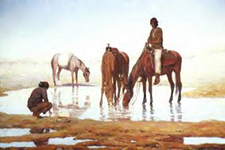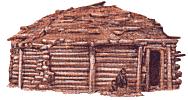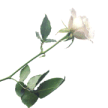 |
||||
 |
||||
‘Ahé’éské
(Marriage) |
| Marriage is an important and sacred institution in Navajo tradition. The ceremony acts to establish harmony between the new couple and the extended families. A special form of Blessingway is performed for the event of marriage. Changing Woman is believed to have taught the wedding (iigeh) ceremony to Navajos. The ceremony, which is still practiced today, typically involves traditional elements and often includes elements of a Western wedding ceremony, such as the Western-style multi-tiered wedding cake and the Western-style opening of presents.
She would pour water (tó) from a pitch-covered jug onto the boy’s hands and he would wash his hands. Next the boy would pour water from the same jug onto the girl’s hands and she would wash her hands. This symbolized purity and cleansing. Next, the medicineman would take the wedding basket in which there was corn meal mush and make a circle of corn pollen on the mush and then make a cross in the center of that circle. While the medicineman was doing that he would be praying quietly, and when he had finished making the decorations on the mush with the corn pollen, the basket would be placed in front of the couple, and the boy would take the first bite – by dipping two or three fingers into the mush and eating from them – at the east where the basket design opens. Next, the girl would take a bite in the same way, and then they would take one bite after the other from the four directions and finally from the center. Usually the young couple was instructed to eat all of the mush themselves, but at some weddings the remaining part of the mush would be passed around so that each member of the boy’s family could get a bite. The traditional Navajo approach would be to have the basket remain stationary in front of the young couple so that it would not be handed around and moved about as different people took bites of the mush with their fingers. The basket of mush is vital to the ceremony and the couple to be married takes small amounts of mush to eat in a specific order: east, south, west and north. Each direction represents stages of life's journey. After the mush has been eaten the basket is given to the mother of the boy who is instructed to keep it and preserve it at all times. Following the completion of eating the mush, food was passed around to all of the guests at the wedding. After this distribution and feasting had been completed, the older and happily married couples would give advice to the young married couples in terms of what to expect and how to live happily and properly with one another. Someone who was respected gave the following remarks:
In the old days the young couple would remain in the hogan following the ceremony, while the guests and visitors would leave and return to their own homes. Today, the bride and groom often leave to go to their own home. The bride's family is responsible for the food to be provided at the feast following the marriage. After the feast, the bride's family gives the leftover food to the groom's. |
 Typically,
a bride would have to be bought. The parents of the suitor would
arrive at the home of the prospective bride with an offer in horses,
sheep or other valuable items that they wish to exchange for a wife.
If the woman's family accepts the gifts, the marriage would take
place within four days.
Typically,
a bride would have to be bought. The parents of the suitor would
arrive at the home of the prospective bride with an offer in horses,
sheep or other valuable items that they wish to exchange for a wife.
If the woman's family accepts the gifts, the marriage would take
place within four days.  hogan
on a horse and is greeted at the door by the bride's father, who
accompanies the young man inside. The groom
entered the hogan with his father or uncle and sat on the west side
of the hogan, his mother beside him. After he had entered
and was seated the girl would enter carrying
the basket of mush, accompanied by her father or uncle. She
set down the basket before her groom and would sit beside the boy
and the two would be facing east – toward the door of the
hogan. The girl would sit on the right side of the boy.The groom’s
family sits to the north of the hooghan, which is the side reserved
for honored guests, and the bride’s to the south.
hogan
on a horse and is greeted at the door by the bride's father, who
accompanies the young man inside. The groom
entered the hogan with his father or uncle and sat on the west side
of the hogan, his mother beside him. After he had entered
and was seated the girl would enter carrying
the basket of mush, accompanied by her father or uncle. She
set down the basket before her groom and would sit beside the boy
and the two would be facing east – toward the door of the
hogan. The girl would sit on the right side of the boy.The groom’s
family sits to the north of the hooghan, which is the side reserved
for honored guests, and the bride’s to the south. Now
you have lit a fire and that fire should not go out. The two of
you now have a fire that represents love, understanding and a philosophy
of life. It will give you heat, food, warmth, and happiness. This
new fire represents a new beginning – a new life and a new
family. The fire should keep burning; you should stay together.
You have lit the fire for life, until old age separates you.
Now
you have lit a fire and that fire should not go out. The two of
you now have a fire that represents love, understanding and a philosophy
of life. It will give you heat, food, warmth, and happiness. This
new fire represents a new beginning – a new life and a new
family. The fire should keep burning; you should stay together.
You have lit the fire for life, until old age separates you.